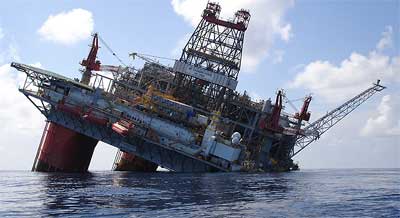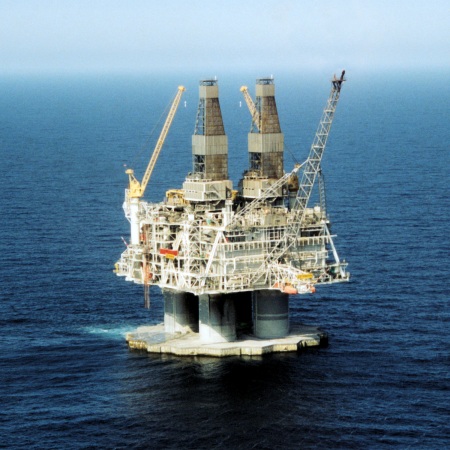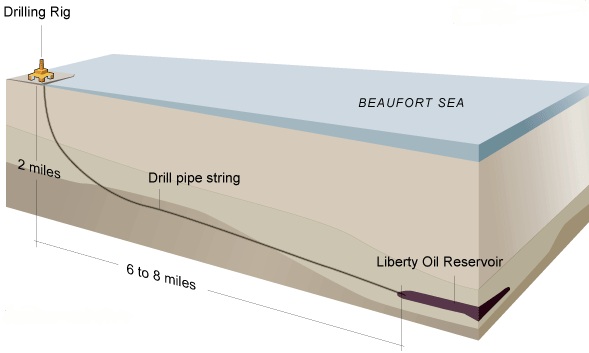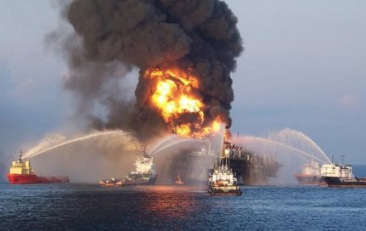Why Disastrous Blowouts Occur
The dragon in the reservoir under the Deepwater
Horizon was held in check by 3 miles of heavy mud.
But the mud and the riser had to be removed before
the Deepwater Horizon could be moved to drill another
well. Before this was done, the lower part of the
well was filled with cement. The dragon would be
contained after the cement set. Then the mud was
replaced by sea water. The blowout occurred when the
dragon blew past the not-quite-set cement. The blind shear ram failed to cut
the drill pipe and the dragon escaped.
The Ixtoc blowout occured in a somewhat similar way.
The drillbit encountered
unconsolidated sand which allowed the mud to escape
down the hole. The operators of the oil rig knew
they were in trouble when mud stopped coming up. They
countered by pumping all the mud they had down the
hole. When the mud ran out, they
activated the blind shear ram and ran for cover. The blind shear ram failed to cut
the drill pipe and the dragon escaped.
Potential for Future Disasters
A dragon, in the form of high pressure, exists in
every deepwater oil reservoir. The fiercest dragons
lurk in the deepest reservoirs. All deepwater oil
reservoirs have the potential for a disastrous blowout.
Nearly all new projects in the Gulf of Mexico are in deep water.
There are thousands of oil oil platforms
interconnected by thousands of
miles of pipe in the Gulf.
The Easy Oil is Gone
The Deepwater Horizon drilled into the relatively small, (50
million barrels) deep, (3 miles) Macondo Prospect
because that was the best place to drill. Of course
an oil company is going to drill in places which
maximize profit. But the best places are mostly
drilled. Only the difficult places are left. This is
true in the Gulf of Mexico as well as the whole
Earth. Here are a few examples;
 The Thunderhorse
oil platform was designed to tap the
Thunderhorse oil field which is located 150 miles
from New Orleans and is 4.5 miles deep. It is owned
jointly by BP and ExxonMobil. Here is a picture of
the Thunderhorse after Hurricane Dennis in 2005. The
pronounced list is due to a plumbing error.
Fortunately, Thunderhorse was not connected to an oil
well at the time.
The Thunderhorse
oil platform was designed to tap the
Thunderhorse oil field which is located 150 miles
from New Orleans and is 4.5 miles deep. It is owned
jointly by BP and ExxonMobil. Here is a picture of
the Thunderhorse after Hurricane Dennis in 2005. The
pronounced list is due to a plumbing error.
Fortunately, Thunderhorse was not connected to an oil
well at the time.
 The Hibernia
oil platform stands in the Atlantic Ocean 196
miles from land and not far from where the Titanic
sank. It does not float. It sits on the sea floor. It
relies on its weight of 1.2 million tons to resist
storms and icebergs. Its oil tanks hold oil enough to
fill the Exxon Valdez 5 times. It costs 5 billion
dollars. It is well worth it because it taps a
reservoir 24 times bigger than the Macondo
Prospect.
The Hibernia
oil platform stands in the Atlantic Ocean 196
miles from land and not far from where the Titanic
sank. It does not float. It sits on the sea floor. It
relies on its weight of 1.2 million tons to resist
storms and icebergs. Its oil tanks hold oil enough to
fill the Exxon Valdez 5 times. It costs 5 billion
dollars. It is well worth it because it taps a
reservoir 24 times bigger than the Macondo
Prospect.
The Hibernia platform has the additional danger of an
iceberg collision. Also, there is no possibility of a
relief well to stop a blowout.
 The Liberty oil field is
inconveniently located off the North coast of Alaska.
BP has an ingenious plan to tap it. They propose
building an 32 acre island 1.5 miles off the coast. A
"super oil rig" is built on the island which is
capable of drilling 3 miles down and 8 miles sideways
to reach the Liberty oil field. This picture comes
from a
New York Times article article which discusses
the risks involved.
The Liberty oil field is
inconveniently located off the North coast of Alaska.
BP has an ingenious plan to tap it. They propose
building an 32 acre island 1.5 miles off the coast. A
"super oil rig" is built on the island which is
capable of drilling 3 miles down and 8 miles sideways
to reach the Liberty oil field. This picture comes
from a
New York Times article article which discusses
the risks involved.
The 8 mile length of the pipe to the oil field
magnifies the "kick" problem as pointed out in the
New York Times article.
The
Tupi oil field is located 160 miles off the coast
of Brazil. At 5 to 8 billion barrels, its size is
comparable to Prudhoe Bay or North Sea oil. But it
will be difficult to produce because the ocean is
6,600 feet deep and the oil is a further 16,000
feet.
It is not easy to drill for oil in places like Iraq,
Kazakhstan and Nigeria for reasons needing no
explanation. The difficulties of producing oil from
Athabasca oil sands, not to mention the environmental
cost, are well known. Efforts to produce oil from
shale continue without success.
The Era of Difficult Oil Begins
Virtually all new oil projects are difficult and pose
dangers to the environment. The oil projects
described above are not cherry picked to emphasize
the difficulties. These descriptions serve as
examples of how astonishingly good modern methods of
finding oil are. There aren't many places for oil to
hide.
The oil projects described above could be described
as ingenious, but they could also be described as
desperate, and a sign the Age of Oil is drawing to a
close.
The oil projects described above could all be
described as dangerous. They all have the potential
of producing Deepwater Horizon scale disasters. This
potential is typical of new projects. It is possible
to predict more disasters.
A Few Random Thoughts
Seven out of eight of the largest corporations on
earth are oil companies. Walmart is number three,
BP is number four.
Any major oil company could become involved in a
Deepwater Horizon scale disaster. They are all
strongly driven by the profit motive. That is not to
exonerate BP--they may be the worst of the bunch.
BP has been seriously hurt by the blowout.
BP's stock has lost half of its value and the
dividend has been cut. BP stock appears in retirement
portfolios of millions around the world. They are the
ones actually paying for the disaster.
In my view, BP should pay for the cleanup and it should
compensate victims. And BP should be fined. My wild
guess for the cost of all this is 100 billion
dollars. BP can survive paying this amount.
The obvious fact is that BP was on a quest for oil
when the blowout occurred, yet the price of oil was
not affected. The market must believe that BP will
not pay and/or that blowouts will not happen again.
Yet, obviously, the blowout will make oil more expensive.
It is safe to say that anyone reading this is an oil
user. We live in the Age of Oil. It is hard to say
it, but we oil users caused the disaster.
 One final thought. We have magical birds called loons here in Wisconsin. They
overwinter in the Gulf of Mexico. Loons, like pelicans, are diving birds.
We hope they come back next spring.
One final thought. We have magical birds called loons here in Wisconsin. They
overwinter in the Gulf of Mexico. Loons, like pelicans, are diving birds.
We hope they come back next spring.
One more final thought. The people of the United States and Europe ignor
the continous environmental catastrophe in the
Niger delta.
Problems there dwarf the Gulf oil spill.
A Personal Note.
If you have read the above, thank you. I invite
comments or questions. I would especially like to hear about
errors in fact or in logic. E-mail me at;
jack@planetforlife.com
